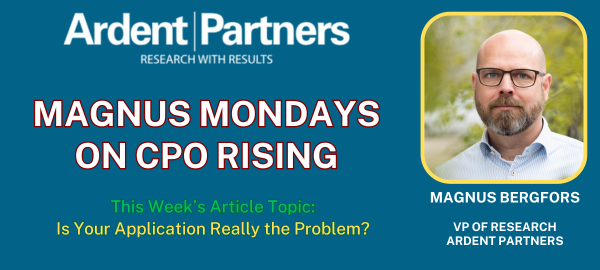As a long-time procurement technology analyst, one of the most frequent questions posed to me is what solution an organization should pick after a previous failed implementation. Or, in other words, “five years ago we picked solution X and now everybody hates it and won’t use it. What solutions should we look at to replace it?” While this is probably all too true, the answer is not to immediately start looking at other solutions. In today’s article, we are going to look at what you need to do before making the decision to switch solutions and solution providers. Since this question most often relates to P2P I will use that as an example. That said, most of the advice can be transferred to any other solution as well.
What are You Trying to Achieve?
The first thing to do is establish your objective and what the solution is intended for. Procurement organizations often have unrealistic expectations of what percentage of its spend is going to be managed through the P2P solution. P2P solutions are great at managing spend categories where you know what you are buying so it can be pre-negotiated and ideally put into catalogs. Yes, a draconian “no PO, no Pay” policy can be put in place that forces end users to create POs, but in many cases, this only adds administration and little value. Also, it will turn the procurement department into some PO police instead of focusing on more important activities.
Make sure you have a clear and realistic objective with the solution and measure and follow up on that. If there is a business case for it, implement category-specific solutions. If you have a business case, observe the next issue.
Have the Intended Users Received Information and Training?
While most modern P2P solutions have intuitive user interfaces, the users must know about them, when to use them, and where to find them. It doesn’t matter what solution you pick if end users don’t know they are supposed to use it. While training shouldn’t be necessary for most users outside procurement, it should be available for those that need or want it.
For organizations with different buying solutions and/or processes, the bigger problem is that end users don’t know what solution or process to use.
Having clear information and a training program alongside the technical implementation is critical to ensure that end users know what to do and what is expected of them. If multiple solutions are used, an intake management and procurement process orchestration solution (IM&PPO) might be a good option.
Is It the Solution or the Implementation?
One key thing to review is the implementation. Are the right suppliers onboarded? Are the catalogs set up to be searchable with the right content and descriptions? Are there clear instructions on what to do if an end user can’t find what they are looking for? Are cost centers and approval workflows set up correctly? Change is hard (for most people) and any excuse not to use a solution and just do “as we’ve always done” will occur.
Use spend analytics to understand what the organization is buying (and who is buying). Work with the suppliers to ensure that articles are tagged correctly and catalogs are properly set up. Make sure cost centers and organization schemas are imported and that workflows are set up to support procurement processes and policies correctly.
What Is It That End Users Don’t Like with the Existing Solution and Why?
Interviewing the end users to understand why they aren’t using the solution as intended might seem obvious but is surprisingly overlooked. Some will point out the issues mentioned above, but there might be other concerns as well. Sometimes it’s a process issue that is unrelated to which solution is being used.
Acting on the users’ input and requirements is key to gaining buy-in and, in the end, adoption of the tools needed.
Reimplement, Replace, or Complement?
Once you have gone through the above, you are in a much better position to understand why your implementation has failed and what you should do next. Today, most solutions are similar so just changing solutions is rarely the answer. In some cases, the current solution might have a bad reputation, making it seem easier to start over completely. But in most cases, you are better off resetting objectives and expectations and doing a full revamp of your implementation.
If your current solution is missing some critical functionality or if ease of use is deemed the major issue, then the best course of action is to go to market again and find a new solution that meets your needs.
Another option is to complement your solution with additional ones. If you are buying a lot of services, then a VMS solution might be ideal. IM&PPO solutions can be used to provide a better user interface and simplify the experience for end users.
The key thing is to understand why your current implementation has failed before deciding what the next step is. As always, Ardent Partners is here to help.
RELATED RESEARCH
Will 2024 be the “Year of Intake Management and Procurement Process Orchestration?”
The Criteria for Selecting Spend Analysis Technology
Corporate Culture and its Impact on Technology Adoption (1)
Corporate Culture and its Impact on Technology Adoption (2)

